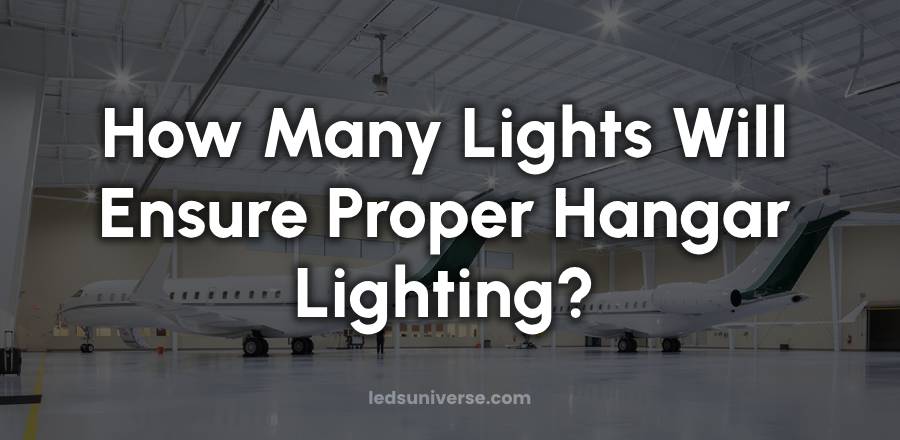Hangars are large spaces that require careful consideration when it comes to lighting. Proper lighting is necessary not only to ensure the safety and visibility of workers but also to make sure that maintenance tasks, inspections, and operations can be carried out effectively. When deciding how many lights are needed, there are several factors that must be considered, including the size of the hangar, the height of the ceiling, the type of work being done, and energy efficiency. This guide will explore how to determine the number of lights that will provide the best possible lighting for a hangar.
Table of Contents
ToggleFactors Affecting the Number of Lights
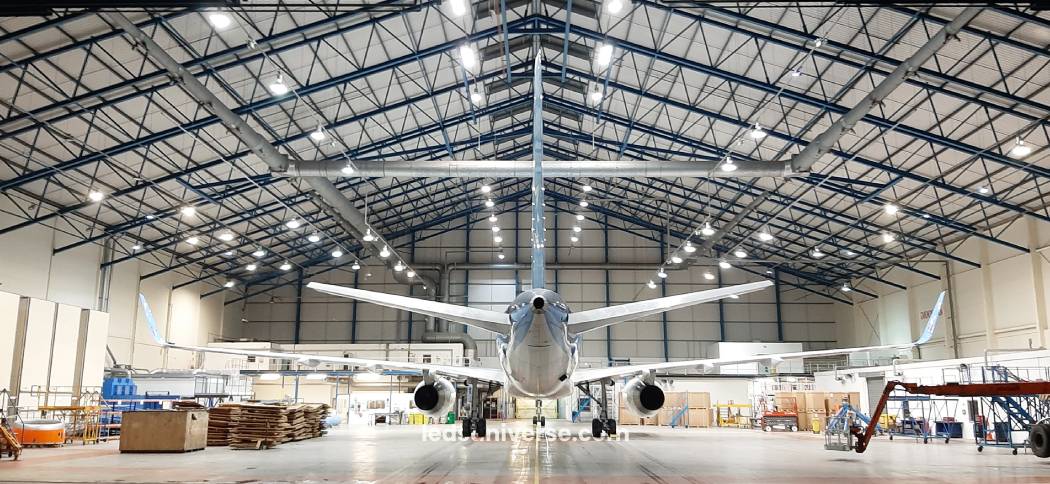
Before determining how many lights a hangar needs, it’s helpful to evaluate a combination of physical, functional, and environmental factors. Lighting a hangar isn’t simply a matter of installing enough fixtures to brighten the space; it’s about creating a balanced environment that supports the daily operations carried out within. Variables such as the hangar’s dimensions, ceiling height, surface reflectivity, interior layout, and purpose all come together to influence how light behaves in the space. Considering these aspects during the design phase can lead to a more efficient layout and better visual comfort for everyone working in the hangar.
Size of the Hangar
The overall square footage of the hangar has a direct impact on the total number of lights required. A small private hangar for one or two aircraft will have vastly different lighting needs compared to a commercial or military hangar spanning tens of thousands of square feet. The larger the space, the more surface area there is to illuminate, which generally translates to a greater number of lighting fixtures. Designers often start with the total area and apply recommended lighting standards, expressed in foot-candles, to estimate the baseline illumination. From there, they adjust based on ceiling height, work tasks, and fixture performance. In rectangular or irregularly shaped hangars, more care must be taken to ensure light coverage reaches into every corner without creating hotspots or dark zones.
Height of the Ceiling
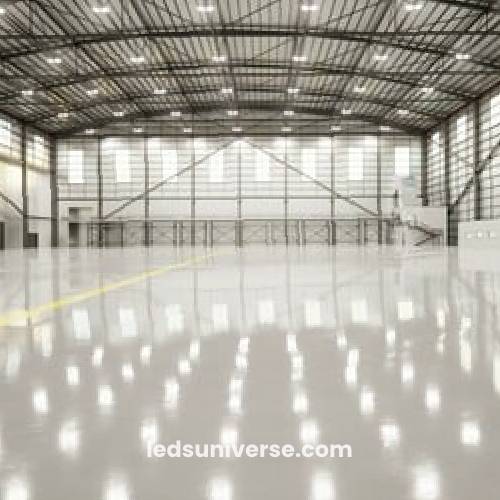 Ceiling height plays a major role in how light travels through the air and reaches the surfaces below. Hangars often feature very tall ceilings to accommodate aircraft of various sizes, meaning fixtures are mounted far from the ground. As the distance between the light source and the working plane increases, more powerful lights or higher mounting angles may be needed to achieve even illumination. The beam spread of each fixture also becomes more relevant as height increases—too narrow a beam may result in focused bright spots, while too wide a beam may cause inefficient coverage. Some fixtures are designed specifically for high-bay applications, distributing light evenly across large distances without creating glare. Factoring in ceiling height early in the design ensures that the chosen lights will perform effectively at those elevations, avoiding shadows or dim zones that could interfere with visibility and workflow.
Ceiling height plays a major role in how light travels through the air and reaches the surfaces below. Hangars often feature very tall ceilings to accommodate aircraft of various sizes, meaning fixtures are mounted far from the ground. As the distance between the light source and the working plane increases, more powerful lights or higher mounting angles may be needed to achieve even illumination. The beam spread of each fixture also becomes more relevant as height increases—too narrow a beam may result in focused bright spots, while too wide a beam may cause inefficient coverage. Some fixtures are designed specifically for high-bay applications, distributing light evenly across large distances without creating glare. Factoring in ceiling height early in the design ensures that the chosen lights will perform effectively at those elevations, avoiding shadows or dim zones that could interfere with visibility and workflow.
Type of Work Performed
The nature of the tasks taking place inside the hangar can dramatically affect lighting needs. Precision activities, such as aircraft inspection, avionics work, and repairs, require higher levels of light to ensure clarity and attention to detail. These zones benefit from task lighting or fixtures with high color rendering to distinguish fine differences in materials, surfaces, and components. In contrast, areas designated for storage, parking, or equipment staging may only require moderate light levels, focused more on general visibility than detailed work. If the hangar is used around the clock or for shift work, lighting might also need to compensate for fatigue and changing light conditions throughout the day. In multifunctional hangars where different types of work occur side-by-side, designers may segment the space and apply different lighting strategies to match each zone’s function. This approach not only supports productivity but also enhances comfort for those working long hours in demanding conditions.
Lighting Types and Their Role in Hangar Design
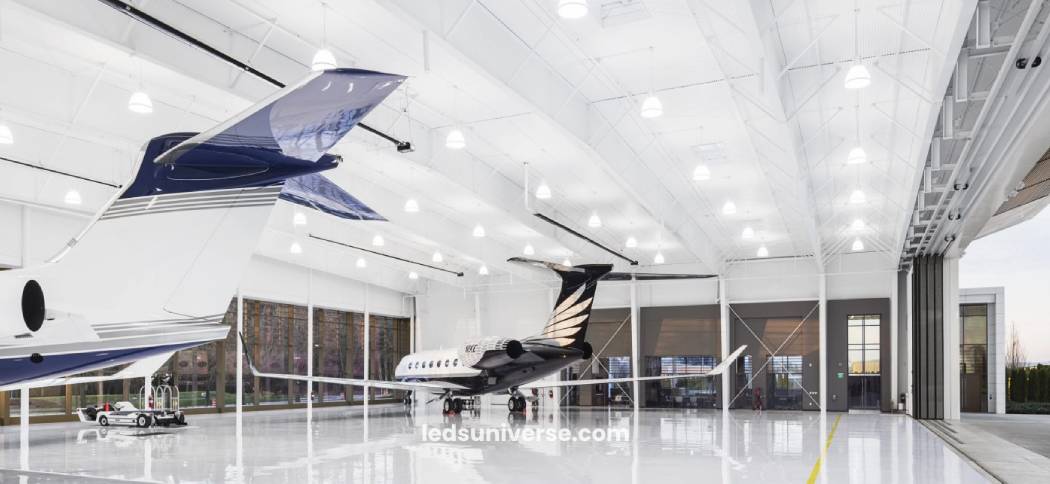
Different types of lighting can be used in a hangar to achieve specific lighting effects and coverage. Each lighting option has distinct advantages, and choosing the right one depends on factors like the layout of the space, the work being done, and the desired level of brightness.
Fluorescent Lights
Fluorescent lights have been a popular choice for hangars for many years due to their ability to provide bright, even lighting. They are relatively energy-efficient compared to traditional incandescent bulbs, making them a cost-effective option for larger spaces. However, fluorescent lights may not be as effective for spaces with high ceilings, as their light can become diffused and may not reach the floor with enough intensity. Additionally, their lifespan is generally shorter than LED lights, which may result in higher maintenance costs in the long run.
LED Lighting
LED lighting is an increasingly popular choice for hangars, thanks to its energy efficiency, longevity, and ability to produce bright, focused illumination. LEDs are available in a variety of intensities and configurations, allowing for flexible design. These lights are ideal for areas with high ceilings and can be strategically placed to ensure even distribution of light across the hangar. Although LED lights may come with a higher initial cost compared to other options, their long lifespan and low energy consumption can provide substantial savings over time.
Metal Halide Lighting
Metal halide lights are another option for hangars, particularly when high-intensity lighting is required. These lights provide a bright, white light that closely mimics natural daylight, which is beneficial for tasks requiring precision. However, they tend to consume more energy than LED lights and may take some time to reach their full brightness. Metal halide lights also have a shorter lifespan than LEDs, which could lead to more frequent replacements and higher maintenance costs.
Lighting Layout and Placement Considerations
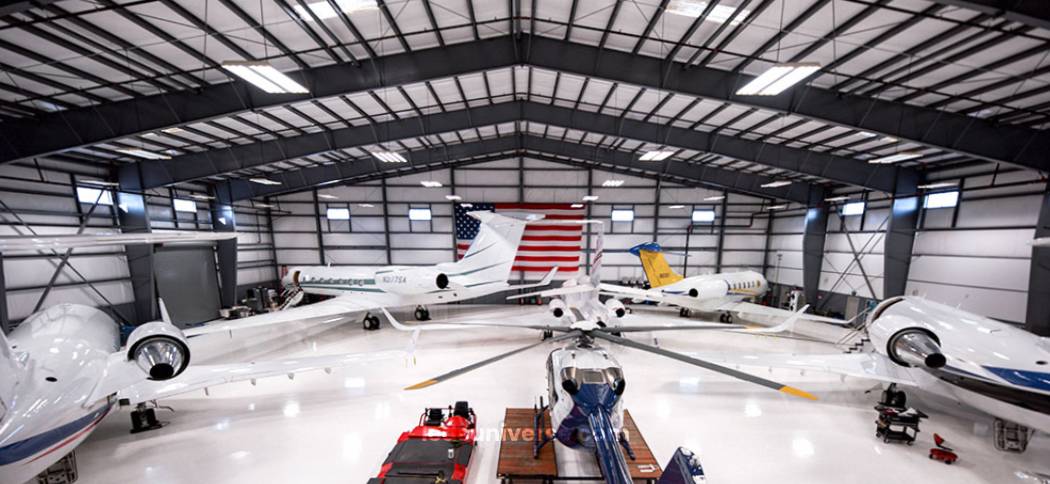
Designing the layout and determining the placement of lighting in a hangar goes beyond selecting the right fixtures. Thoughtful arrangement of lights can enhance visibility, improve work accuracy, and support a more comfortable environment for staff. Hangars are typically large and open, which means improper lighting placement can lead to dark corners, unwanted glare, and wasted energy. By considering the dimensions of the space, ceiling height, and intended tasks, a balanced lighting scheme can be developed that meets operational needs without overloading the system. A well-planned layout not only contributes to effective lighting but also ensures that the entire area is used efficiently.
Spacing Between Lights
The spacing between light fixtures has a direct impact on how evenly the light spreads across the hangar floor. If fixtures are too widely spaced, uneven brightness can occur, leaving certain areas underlit and potentially hindering productivity. On the other hand, placing lights too close together can create overlapping beams that lead to hot spots, glare, or uncomfortable brightness levels. The ideal spacing is often determined by the height of the ceiling, the beam angle of the lights, and the lumen output of each fixture. For high-ceilinged hangars, wider spacing with higher-output lights may work well, whereas lower ceilings may benefit from closer spacing and lower-wattage lights. Attention to these details helps maintain a consistent light level across the entire space without wasting energy or creating distracting visual effects.
Light Intensity and Distribution
Light intensity refers to how brightly a fixture illuminates an area, while distribution is about how that light spreads from the source. In a hangar environment, getting both of these aspects right is key to achieving the desired lighting conditions. Areas that involve technical tasks, such as repairs or inspections, will need lights that emit higher levels of brightness with a narrower focus to avoid shadows and highlight fine details. In contrast, areas used for general movement or storage can be illuminated with lights that have a wider spread and lower output. Choosing the correct fixtures means balancing brightness with coverage—ensuring each zone receives enough illumination without excessive concentration or waste. Adjustable or directional lighting can also be used to fine-tune the focus, particularly for workstations or hard-to-reach spaces.
Lighting for Specific Zones
Hangars often serve multiple functions within a single space, which makes a uniform lighting approach less effective. Dividing the area into functional zones allows for tailored lighting strategies that match the needs of each section. Work zones where precision tasks are carried out may benefit from task lighting with higher color rendering and sharper focus. Walkways, storage racks, and less active areas can be illuminated with ambient lighting that offers a broader, softer distribution. Additionally, incorporating controls such as dimmers or motion sensors in certain zones allows for flexibility based on usage patterns throughout the day. This kind of zoning not only enhances the usability of each area but also helps conserve energy and reduce strain on lighting systems. When each section is lit based on its specific purpose, the entire hangar becomes a more productive and functional workspace.
Energy Efficiency and Cost Considerations
When determining how many lights are required for a hangar, it is also important to consider the energy consumption and long-term costs associated with the lighting system. Since hangars tend to be large spaces that require sustained lighting, choosing energy-efficient options can lead to substantial savings over time.
Energy-Saving Lighting Solutions
LED lights are an excellent choice for energy efficiency. They consume significantly less energy than traditional incandescent or fluorescent lights while providing the same or better lighting output. Over the lifespan of the lights, the savings on electricity bills can be considerable. Additionally, LEDs generate less heat, which can be a factor in keeping the hangar environment comfortable for workers.
Maintenance Costs
Energy-efficient lighting options, such as LEDs, generally have a longer lifespan compared to other types of lighting. This translates into fewer replacements and less maintenance. Given that hangars are large spaces and often require lights that are positioned high up, regular maintenance can be costly and time-consuming. By investing in durable lighting solutions, the need for maintenance and replacements can be reduced, leading to long-term savings.
Determining the Right Number of Lights
Figuring out how many lights are needed to illuminate a hangar effectively involves a combination of technical assessment, practical judgment, and the application of standard lighting principles. Each hangar has its own unique characteristics, and what works for one space may not be suitable for another. A carefully developed lighting strategy takes into account the dimensions, structure, usage, and reflective qualities of the hangar. Without a tailored approach, lighting can become either insufficient or excessive, leading to discomfort, wasted energy, or reduced visibility in key areas. By evaluating the physical and functional attributes of the space, a plan can be created that delivers the right light levels where they are needed most.
Several foundational factors need to be evaluated before settling on the number of fixtures required. These include the total square footage of the hangar, the mounting height of the lighting fixtures, the layout of equipment and aircraft, and the nature of the activities taking place. These elements influence how much light is needed and how it should be distributed. A lighting solution that works well for a hangar used primarily for storage may fall short in a facility where technicians are performing delicate repair or inspection work. Adjusting for these conditions is an essential step toward achieving effective coverage and usability.
Professionals often rely on lighting design tools to help calculate the number and placement of fixtures. Software programs and online calculators allow for precise modeling of a space, taking into account variables like lumen output per fixture, beam angles, ceiling height, and surface reflectivity. These tools simulate how light will interact with the environment, showing whether the proposed layout will achieve even coverage or leave areas underlit. They also help avoid guesswork by offering data-driven estimates that reflect real-world performance. In complex hangar environments, this level of analysis becomes a valuable part of the planning process, ensuring the lighting performs as expected once installed.
Lighting guidelines from recognized institutions such as the Illuminating Engineering Society (IES) are often used as references during the planning process. These guidelines suggest recommended light levels for different types of spaces and activities. While they are not mandatory in all cases, they provide a reliable framework for creating effective lighting conditions. For instance, the suggested illumination for general storage areas is typically lower than for zones where detailed tasks are performed. By aligning the lighting plan with these guidelines, designers can ensure that the space supports the tasks being performed while avoiding unnecessary overuse of fixtures.
Flexibility also plays a role in determining fixture count. In some hangars, lighting needs may change over time as activities shift or as equipment is added. A modular or scalable lighting setup can allow for future adjustments without the need for a full redesign. Incorporating controls such as dimming systems, motion sensors, or zoning options makes it easier to adapt the lighting environment as requirements evolve. This approach offers long-term value by supporting both current and future needs without sacrificing consistency or effectiveness.
Conclusion
The right number of lights for a hangar is determined by several factors, including the size and layout of the space, the type of activities performed, and the type of lighting selected. A combination of lighting solutions, carefully placed and properly spaced, will ensure that the hangar is adequately illuminated for safety and efficiency. By considering energy-efficient options and planning for long-term maintenance, hangar lighting can be both effective and cost-efficient. The ultimate goal is to create a well-lit environment that supports daily operations and enhances the safety and productivity of the workers in the hangar.
